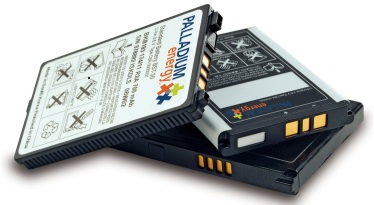Battery technology moves hand in hand with advancements across some of our most impressive advancements including portable every things, electric vehicles, as well as military and space wizardry. Electronic Products Magazine asked Palladium Energy, Texas Instruments, and Varta what they thought were the short-term and long-term battery trends.
Monika Minarcin, Senior Business Development Manager at Palladium Energy says that “Today, many consumer battery packs are stretched to contain extended series-parallel arrangement of cells to meet capacity and power in increasingly varied and hostile environments. The increasing pressure to miniaturize components and subsystems of portable electronic devices reduces the amount of thermal mass from the host system. However, the system is still producing the same heat loads and is under even further stress. Following recent high-profile lithium battery safety incidents, producing a safe battery pack is becoming a chief concern for OEMs and consumers alike. In order to achieve safety in an evolving environment, the industry needs to better understand failure modes, develop better characterization tools, and learn from the improvement of energy storage technology safety.

Palladium makes lithium-based battery technologies. The company specializes in custom-designing and manufacturing battery packs for a variety of industry applications including automotive telematics to medical X-rays. They specialize in Li-ion, LiFePO4, Li-polymer, and supercapacitors.
Palladium Energy
www.palladiumenergy.com
“Most importantly, the commercial market must add safety layers into the balancing, failure forecasting, and detection of catastrophic event precursors in order to maximize the operational safety of cells, module and packs. Diagnostic methods that alert the battery management system to incipient failures would pay big dividends in preventing major incidents. The final goal is to develop diagnostic techniques that can identify an incipient failure and take action early enough to prevent thermal runaway. Diagnostics, artificial intelligence, or other data analysis techniques will need to be developed to predict failure. Today, most battery packs have two or three defensive layers, but a best-in-class pack should have more than three defensive layers.”
Upal Sengupta, Staff Applications Engineer with the TI Battery Management Solutions group, says that “lithium-ion batteries started out as a 'niche market' product years ago, but are now used in many diverse applications with power levels from milliwatts to kilowatts. As the range of application cases grows, we will see more specialized versions of Li-ion optimized for specific types of performance.
“The original Li-CoO2 batteries were optimized for high capacity at moderate discharge rates. For the first several years after the commercialization of Li-ion technology (1990s), most R&D efforts were focused on increasing energy density (mAH capacity), with the primary applications being portable computers and mobile phones. After that, newer variations such as Li-Mn2O4 and Li-FePO4 were developed that provided higher instantaneous power capability (albeit at lower capacity) for applications like power tools and electric vehicles. Additionally, much recent effort has been directed at cost reduction of Li-iIon batteries (primarily by reducing cobalt content).

The bq24190, bq24192, bq24192I, and bq24193 are highly-integrated switch-mode battery charge management and system power path management devices for single cell Li-Ion and Li-polymer battery in a wide range of tablet and other portable devices.
Texas Instruments
www.ti.com
“Li-NMC (nickel-manganese-cobalt) cells have recently emerged as a new standard. This type of cell can be optimized for high capacity or high-peak-current capability. Some of these cells are designed to be charged up to slightly higher voltages, yielding higher capacity per cycle. R&D efforts continue with new materials like Silicon anodes that promise further capacity increases. Higher capacity cells may have operating voltages that go above and below the traditional 3.0 to 4.2-V range. This will require new types of electrolytes to maintain stability and safety, as well as more flexible battery management and power conversion circuitry.”
Julia Palu Vice President of Marketing at VARTA Microbattery observed that “ A growing trend in the battery industry and in general for manufacturing, electronics, and consumer industries is the increase in social and environmental responsibility. Leading manufacturers are investing in “green” products, are supporting recycling programs, taking care of the health of the planet, giving back to communities. Significant R and D is being used for bringing innovative battery technologies to the market. VARTA Microbattery has developed and produces state-of-the-industry mercury-free technologies like zinc air, silver oxide, high temperature nickel metal hydride and nickel zinc.

The mercury-free primary Nickel-Zinc (NiOOH) Button battery system uses nickel zinc cells developed as a cost effective substitute to conventional primary silver oxide (Ag2O) button cells. It is a low voltage power source for watches, medical devices, calculators, toys, remote controls, and laser pointers.
Varta Batteries
www.varta-microbattery.com/
“As increasing numbers of companies look for ways to reduce operating expenses and “become green,” nickel metal hydride batteries offer an alternative solution for telecom, UPS, servers and other data storage applications. This technology provides not only environmentally compatible high energy but also exceptional performance, reliability and safety under extreme operating conditions like high temperature and discharge power.
“Another notable trend is the increase in demand for stationary energy storage solutions. Complex storage batteries with the integrated energy management systems optimize the utilization of the solar power yet can just as easily be fed with wind or hydro power. Compact lithium ion energy storage solutions developed by VARTA Storage ensure that independently produced energy is available when needed. For example, depending on a household's requirement, it provides the power for home use, or feeds it into the grid. The performance of latest energy storage batteries ensure that solar power is becoming even more cost efficient for individuals who own, or are thinking of buying, a photovoltaic system. “
Advertisement
Learn more about Electronic Products Magazine





